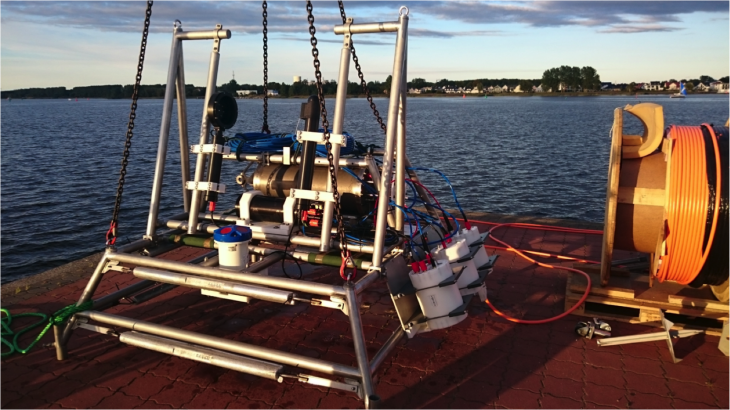Zooplankton Recorder (MOKI)

-image: Hans-Jürgen Hirche / AWI-
Rapid mapping of plankton abundance in combination with taxonomic and size composition will be undertaken using the zooplankton recorder MOKI (figure: a predecessor type). The zooplankton recorder can provide high-resolution images of minute objects below 100 μm. Its modular configuration enables the device to be towed by research vessels, to be a component of the FerryBox or to be installed on unmanned platforms, or underwater nodes.
Images of dominant plankton groups can be classified by software and objects can be assigned to their respective environmental parameters: depth, temperature, salinity and oxygen concentration. The instrument has been developed and will be modified and operated by Alfred Wegener Institute.
The Underwater Plankton and Particle Observatory

The Underwater Plankton and Particle Observatory after a test deployment in the Baltic Sea. -Image: Klas Ove Möller/Hereon-
To improve our understanding of plankton and particle dynamics the department Marine snow & Plankton employs new methods (e.g. underwater imaging systems) to elucidate these processes and improve our understanding of marine ecosystems and the biological carbon pump.
To overcome the limitation of traditional sampling methodsa novel underwater plankton and particle observatory has been developed which has been recently deployed in the German Bight (southern North Sea) close to the island of Helgoland. The cabled underwater observatory combines a remote-controlled Video Plankton Recorder (VPR), Acoustic Doppler Current Profiler and CTD-probe allowing continuous and automatic small-scale observations in near real-time.
This non-invasive sampling approach allows the quantification of marine snow aggregates and, hence, serves as an optical particle trap. Furthermore, plankton abundance and behavior (e.g. vertical migration and trophic interactions) as well as the associated hydrography can be observed covering temporal scales from minutes to several months.
| Zooplankton species | Zooplankton size |
